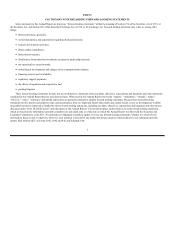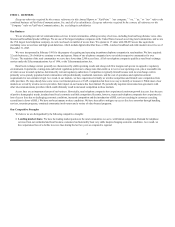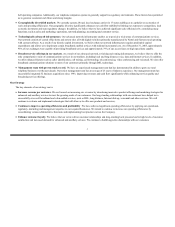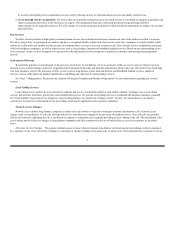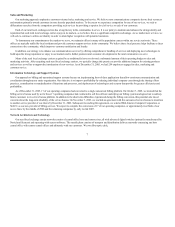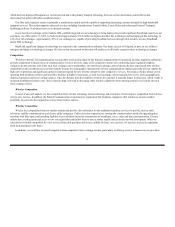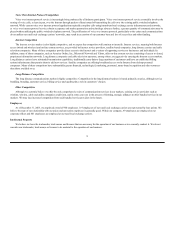FairPoint Communications 2005 Annual Report Download - page 11
Download and view the complete annual report
Please find page 11 of the 2005 FairPoint Communications annual report below. You can navigate through the pages in the report by either clicking on the pages listed below, or by using the keyword search tool below to find specific information within the annual report.
Voice Over Internet Protocol Competition
Voice over internet protocol service is increasingly being embraced by all industry participants. Voice over internet protocol service essentially involves the
routing of voice calls, at least in part, over the Internet through packets of data instead of transmitting the calls over the existing public switched telephone
network. While current voice over internet protocol applications typically complete calls using incumbent local exchange carrier infrastructure and networks,
as voice over internet protocol services obtain acceptance and market penetration and technology advances further, a greater quantity of communication may be
placed without utilizing the public switched telephone network. The proliferation of voice over internet protocol, particularly to the extent such communications
do not utilize our rural local exchange carriers’ networks, may result in an erosion of our customer base and loss of access fees and other funding.
Internet Competition
The Internet services market is also highly competitive, and we expect that competition will continue to intensify. Internet services, meaning both Internet
access (wired and wireless) and on-line content services, are provided by Internet service providers, satellite-based companies, long distance carriers and cable
television companies. Many of these companies provide direct access to the Internet and a variety of supporting services to businesses and individuals. In
addition, many of these companies, such as America Online, Inc., Microsoft Network and Yahoo, offer on-line content services consisting of access to closed,
proprietary information networks. Long distance companies and cable television operators, among others, are aggressively entering the Internet access markets.
Long distance carriers have substantial transmission capabilities, traditionally carry data to large numbers of customers and have an established billing
system infrastructure that permits them to add new services. Satellite companies are offering broadband access to the Internet from desktop personal
computers. Many of these competitors have substantially greater financial, technological, marketing, personnel, name-brand recognition and other resources
than those available to us.
Long Distance Competition
The long distance communications market is highly competitive. Competition in the long distance business is based primarily on price, although service
bundling, branding, customer service, billing service and quality play a role in customers’ choices.
Other Competition
Although we currently believe we offer the only comprehensive suite of communications services in our markets, existing service providers such as
wireline, wireless, cable and utility companies could form, and in some cases are in the process of forming, strategic alliances to offer bundled services in our
markets. We may face increased competition from such bundled service providers in the future.
As of December 31, 2005, we employed a total of 900 employees. 119 employees of our rural local exchange carriers are represented by four unions. We
believe the state of our relationship with our union and non-union employees is generally good. Within our company, 99 employees are employed at our
corporate offices and 801 employees are employed at our rural local exchange carriers.
We believe we have the trademarks, trade names and licenses that are necessary for the operation of our business as we currently conduct it. We do not
consider our trademarks, trade names or licenses to be material to the operation of our business.
9



